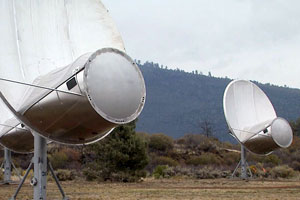SETI's powerful new tool
Before the Allen Array, Tarter and other SETI scientists took their equipment around the world, borrowing time from telescopes owned by other institutions. But with Allen, which was constructed with money from Microsoft co-founder Paul Allen and is jointly managed with the University of California, Berkeley, SETI scientists could scan the skies full-time, hoping a clear, tell-tale radio signal would distinguish itself from the universe’s background hiss.
“We look,” says Tarter, “for signals that are compressed in frequency. Because nature doesn’t do that, technology does.”
Tarter is the first to admit that this may never work. She says SETI is searching the cosmic haystack for a needle that might not even exist.
Ben Zuckerman, a professor of astronomy at UCLA, is skeptical humans will ever find intelligent extra-terrestrials.
“Frankly I don’t think technological ETs exist in our Milky Way galaxy,” says Zuckerman. “Or if they do, they’re very, very scarce.”
Zuckerman didn’t always feel this way. In grad school, he studied with Carl Sagan. He even worked on some of the early radio searches back in the 1970s. But then he started to have doubts.
“If there are so many technological civilizations out there, and they’re so far in advance of our own technological civilization, then why haven’t they found us?”
Then there’s the problem of timing. If intelligent ETs are out there, what are the odds that their signals would reach Earth at the precise moment in cosmic history that we happen to be listening?
NASA's Kepler Mission delivers new targets
Recently, something happened that gave critics new hope: NASA’s Kepler Mission, a program designed to survey the Milky Way galaxy in search of Earth-size and smaller planets, delivered its results.
Kepler found what it was looking for: More than a thousand planets orbiting distant stars like our sun. Dozens of them are thought to be roughly Earth-sized. Of those, some may turn out to have climates that could be hospitable to life.
Dimitar Sasselov directs Harvard’s Origins of Life Initiative and is also a member of the Kepler team. He says Kepler has given SETI something it never had before: targets.
“This is where we should be looking for the signals coming from other civilizations,” says Sasselov, referring to the so-called Kepler planets. “SETI is already in possession of this list.”
As of April, that list has been filed away for future use. SETI’s Allen Telescope Array is officially in “hibernation.” Tight budgets at the state and federal level have left UC Berkeley without enough money to operate the telescopes. Sasselov says it’s a shame.
“This is our only shot to listen for such signals,” he says. “When the array is down, we are blind and we are deaf.”
The "longest long shot"
Jill Tarter says it would cost $5 million and two years to systematically go through the Kepler planets, listening for radio signals produced by an intelligent civilization. She’s looking for private money to make it happen.
Even Ben Zuckerman, the UCLA skeptic, believes that’s a small price to pay. “Given that the costs are not very high,” he says, “why not continue the search?”
Zuckerman says it’s a long shot. Maybe the longest long shot in the history of science. But the payoff?
“The payoff, one could argue, is the most important science discovery of all time.”
There are hundreds of billions of stars in our Milky Way galaxy alone, and hundreds of billions of galaxies. Tarter says someday, it may make sense to stop looking, to come to what she calls the “extraordinary conclusion” that we really are alone.
“It isn’t an impossible conclusion,” says Tarter. “That may be the answer. But it certainly isn’t time to draw that conclusion. Let’s search a little more. A lot more, actually.”
40.791111 -121.504722
 The Allen Telescope Array near Redding, California
The Allen Telescope Array near Redding, California